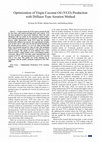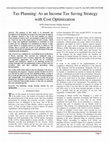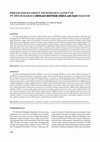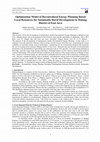Papers by Rahaju Saraswati
Nucleation and Atmospheric Aerosols, 2022

European Journal of Engineering and Technology Research, 2021
Virgin coconut oil (VCO) is pure coconut oil with low free fatty acid content and high lauric aci... more Virgin coconut oil (VCO) is pure coconut oil with low free fatty acid content and high lauric acid content. VCO has been produced in many home industries where the yield obtained is still very small. So, the researchers tried to find a more efficient production process so that they could obtain high process yields. Researchers made VCO using the aeration method with a diffuser type aerator. The experimental variables were air flow rate (L / min): 0.6; 1.8; 4.0; 4,5 and the duration of the aeration process (hours): 2; 3; 4; 5, by using coconut milk from 1 kg of grated coconut in 1 liter of water, the maximum yield is 33.5% at an air flow rate of 4.0 L / min with an aeration time of 4 hours. The quality of VCO obtained were: water content of 0.02%; iodine number 5,54%; peroxidation number 1.36 g.iod / 100 g; 0.19% free fatty acids; saturated fatty acid content of 93.71% and unsaturated fatty acid 6.24% and the color is very clear. The quality test results obtained are in accordance wi...

IOP Conference Series: Materials Science and Engineering, 2021
ZnO-based solid catalyst was successfully synthesized with two types of catalyst support that is ... more ZnO-based solid catalyst was successfully synthesized with two types of catalyst support that is gamma alumina and multi walled carbon nanotubes (MWCNTs). Those catalyst would be used to produce biodiesel from Kesambi (Schleichera oleosa) oil via transesterification reaction. The aims of this study are to compare the performance of catalyst support that are gamma alumina and multi walled carbon nanotubes (MWCNTs) for transesterification of Kesambi (Schleichera oleosa) oil. The two kinds of catalyst are gamma alumina supported zinc oxide – copper oxide (ZnO-CuO/γ-Al2O3) and multi-walled carbon nanotubes supported zinc oxide (ZnO/MWCNTs). All of the catalysts were prepared by a combination of precipitation, impregnation, and gel process that familiarly called by Stober process. All of the catalysts, then were analysed by X-ray diffraction (XRD), N2 adsorption-desorption followed by Brunauer-Emmett-Teller (BET) calculation and Scanning electron microscopy (SEM). The yield of biodiesel ...
Project portfolio selection is an activity to select proposal of projects either for a new projec... more Project portfolio selection is an activity to select proposal of projects either for a new project or project underway in order to accomplish the organization’s objective without taking the existing restrictions. This paper focuses on the decision making process for project proposal selection currently applied by Shipping Company. First step is to identify the criterion used by the management team for project selection. Next step is to evaluate projects by means of scoring model. Further step is to do risk and financial analysis by using financial model and Monte Carlo simulation. Then, for selecting optimum portfolio, method 0-1 integer linear programming is used. Analysis result of this paper shows that the optimum evaluation steps taken in selecting a project portfolio are the decision to select project B and project C.

International Journal of Research and Innovation in Social Science, 2021
The purpose of this study is to determine the description of tax planning on income taxes that mu... more The purpose of this study is to determine the description of tax planning on income taxes that must be paid by the company. Income is one of the most popular tax objects where taxpayers tend to carry out strategies or plans for income tax. Taxes are one of the main sources of state revenue, which has a large and significant contribution to contribute to state revenue. For tax companies it is considered an expense, so that certain efforts or strategies need to be made to reduce it. The strategy that is carried out is part of tax planning, often the strategy used in this tax planning is to take advantage of the gaps contained in the taxation law. This research was conducted by researching based on literature or library materials. This research was conducted using a conceptual approach and a statutory approach. The conceptual and regulatory approaches are carried out by examining concepts and regulations related to tax planning, income tax savings strategies and cost optimization. Sources of data used are secondary data and data collection procedures using documentation. The results of this study indicate that tax planning is the process of organizing the taxpayer / taxpayer group's business in such a way that the tax debt is in the most minimal position, as long as this is made possible both by the provisions of taxation legislation and commercially. Cost optimization can be carried out in tax planning by changing costs with fiscal corrections to costs that can be deducted from taxable income, so that this tax planning does not contradict the law.

Jurnal Teknik Industri, 2012
PT Dok dan Perkapalan Surabaya (DPS) is one of several strategic BUMN in marine field. With BUMN ... more PT Dok dan Perkapalan Surabaya (DPS) is one of several strategic BUMN in marine field. With BUMN restructurisation and efficiency program from Government, PT DPS is liable to improve its production system efficiency. Many problems that faced by PT DPS to improve its production system efficiency are : (1)There is waste work shop such as work in process, waiting time, and flow time at fabrication process in PT DPS, (2) Because waste work shop is still big, shop production process efficiency has not reached maximally yet, (3)Layout and facilities of PT DPS today is already suitable with concept of Product Oriented Work Breakdown Structure (PBWS), but it is limited at simple construction form. At this research, there is ship production process design with Process Lane Construction and Zone Outfitting method or it is known with Group Technology Layout (Manufacturing Cell System) term in order to solve inefficiency problem at ship production process in PT DPS. Design process is performed ...

Journal of Energy Technologies and Policy, 2015
This research will be the development of optimization models Decentralized Energy Planning in Mal... more This research will be the development of optimization models Decentralized Energy Planning in Malang in East Java , Malang regency due to the potential in the livestock sector and the Agriculture of substantial , but in 2011 there were 42 villages that still have not been electrified villages spread over 29 in 13 districts. The purpose of the development of optimization models Decentralized Energy Planning , in this study is to minimize costs and maximize efficiency district energy systems in poor rural East Java , maximizing the system reliability of renewable energy sources technologies , minimizing the use of petroleum products and maximize the use of existing local resources Malang district of East Java. Research also has the goal of environmental protection is the minimization of greenhouse gas emissions such as CO2 and NO. For rural energy planning in this study , used the Long-range Energy Alternatives Planning System (LEAP) which is based on the model of Linear Programming .This research has been conducted on the analysis of the energy situation in Malang in East Java. Sources of electrical energy are still not able to optimally meet the needs of the community in Malang East Java. But non-commercial energy such as biodiesel , and alternative energy such as micro-hydro power plant personnel has not been sought and utilized optimally. And also known elasticity of energy consumption in Malang on GDP at constant prices is bad , that is within the range of values which is above the 1.3 national energy elasticity. To describe the energy system in Malang district of East Java modules used in LEAP .
Uploads
Papers by Rahaju Saraswati